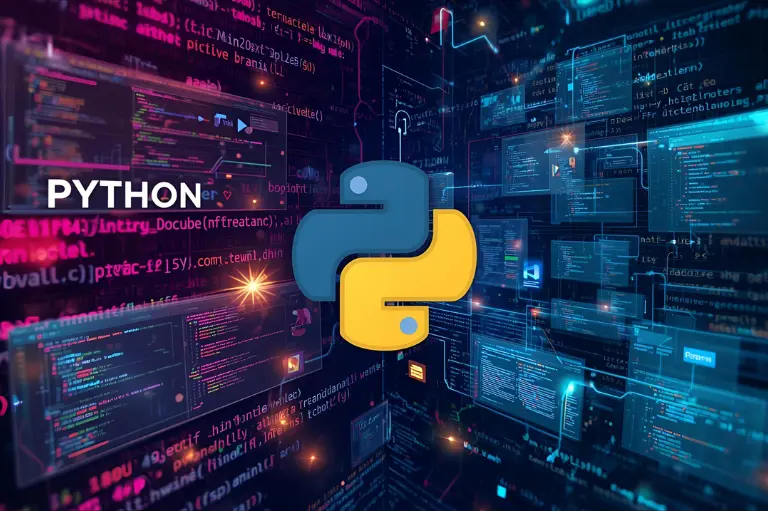
Python Programming Language (Py) is essential for both beginners and professionals. Its versatility helps developers build intelligent applications, automate complex workflows, and explore advanced fields like artificial intelligence, IoT, and cloud computing. Learning Python not only enhances coding efficiency but also prepares you for future innovations in technology.
Python is a high-level, open-source, and general-purpose programming language created by Guido van Rossum in 1991. Known for its clean syntax and readability, it emphasizes simplicity, making it easier for beginners to learn and professionals to master.
Python supports multiple paradigms such as object-oriented, functional, and procedural programming. Because of its flexibility, it is used in domains ranging from web development to data analysis, AI, and automation.
| Property | Python | Other Languages (C, C++, Java) |
| Ease of Learning | Very beginner-friendly | Steeper learning curve |
| Syntax | Simple and readable | Verbose and complex |
| Memory Management | Automatic (Garbage Collector) | Manual or semi-automatic |
| Compilation | Interpreted | Mostly compiled |
| Speed | Slower (interpreted) | Faster (compiled) |
| Libraries and Frameworks | Extensive | Moderate |
| Use Cases | Web, ML, AI, Automation, IoT | System programming, enterprise apps |
Python allows developers to focus on logic instead of syntax, while languages like C++ or Java require more boilerplate code.
def greet(name):
print(f"Hello, {name}! Welcome to Python.")
greet("Robert")
One of Python’s strongest points is its vast ecosystem. Its standard library offers modules for file handling, web services, data manipulation, and much more.
A major advantage of Python is its ability to run on multiple operating systems without modification. You can write a script on Linux and execute it on Windows or macOS with no changes. This cross-platform compatibility reduces development overhead and increases productivity for developers building portable applications.
Python is the leading language for data science and machine learning. Its simple syntax and powerful libraries make it ideal for handling large datasets and building predictive models.
Whether it is forecasting trends, analyzing datasets, or automating insights, Python plays a key role in driving innovation in data science.
Python’s frameworks, like Django and Flask, make it a perfect language for building powerful and secure web applications. Django simplifies large projects, while Flask offers flexibility for smaller or experimental builds.
From startups to major platforms like Instagram and Spotify, many successful applications rely on Python for web development because of its scalability and efficiency.
| Aspect | Python | Java | C++ |
| Syntax | Simple and concise | Verbose | Complex |
| Execution | Interpreted | Compiled (JVM) | Compiled (Binary) |
| Speed | Moderate | Fast | Fastest |
| Use Case | AI, Data, Web | Enterprise, Mobile | Games, System Software |
| Memory Management | Automatic | Automatic | Manual |
| Learning Curve | Easy | Moderate | Difficult |
Use Python when:
Avoid Python when:
| Feature | Benefit |
| Ease of Use | Simple, readable, beginner-friendly |
| Community | Active global developer support |
| Libraries | Extensive for data, AI, and web |
| Speed | Slightly slower but efficient |
| Cross Platform | Runs anywhere with no changes |
| Integration | Works easily with other languages |

Python’s balance of simplicity, power, and flexibility makes it one of the most popular programming languages in the world. Whether your focus is data science, machine learning, web development, or automation, Python provides the right tools and community support to help you succeed.
When comparing Python vs other programming languages, it becomes clear that Python is not just about writing code; it is about writing code that is efficient, elegant, and future-ready. So, if you are an aspiring developer or a professional looking for a reliable language to master, Python is an excellent place to start.
Python emphasizes readability, flexibility, and ease of use, while other languages like C++ or Java focus on speed and strict structure.
Dynamic typing, strong community support, cross-platform compatibility, and a vast standard library.
Yes, Python is the most popular language for both fields, thanks to libraries like Pandas, NumPy, and TensorFlow.
Python is easier to learn and more versatile, while Java and C++ are faster and better for performance-critical software.
Yes, Python code runs smoothly on Windows, macOS, Linux, and other operating systems without modification.
Indian Institute of Embedded Systems – IIES